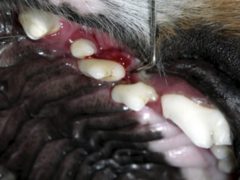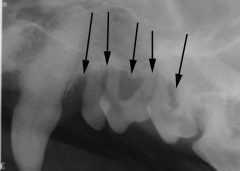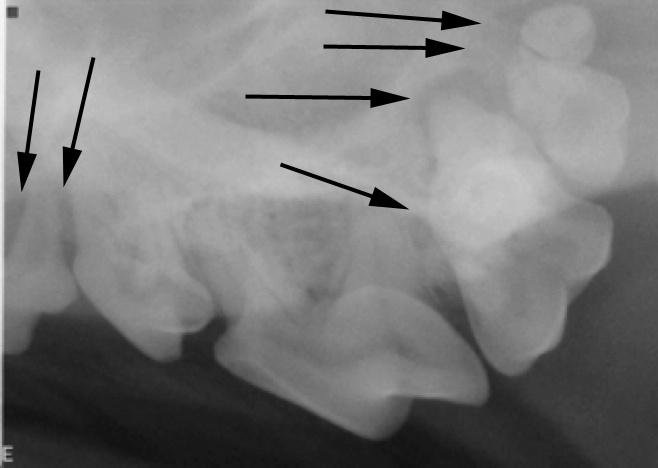Anesthesia-free pet dentistry (AFD) has gained popularity over the last few years. The main factors driving this are the lower cost and the perceived risk of general anesthesia. This is true; AFD is cheaper and has no anesthetic risk. It is hard to fault the owner for seeking treatment that they think is equal to what a veterinary clinic offers but costs less and is safer. Unfortunately, AFD brings with it other risks and leaves many (if not most) patients to suffer silently from unrecognized dental pathology. Owners think they received a valuable service, when in fact they and their pets benefited very little. AFD services overstate the risks of anesthesia and prey on owner’s fear. Clients sometimes relate horror stories about someone who had a pet die while anesthetized for a routine procedure, such as a dental cleaning. Many times this information is second or third-hand information. When the facts of the case are researched, there is usually a reason for the problem; lack of pre-surgical screening to identify underlying problems that might affect anesthesia, not using IV fluids, using substandard monitoring or use of outmoded anesthetic protocols. The resulting hypotension, hypothermia and dehydration can all prolong the recovery of the patient. This article will cover why AFD is a poor idea and help give you some information to educate your clients about their pet’s dental health. Owners usually want the best for their pets. You need to take the time to explain why AFD is not in their pet’s best interests. The following points can all be used for client education.
Figures 1, 2 and 3 below are photos and dental x-rays from a dog that had received regular non-professional teeth cleaning without anesthesia for many years. When the dog started to have difficulty eating her food the owner suspected that there might be problems that had not been detected. The dog needed close to 2 dozen teeth extracted because of advanced, severe periodontal disease. This is a prime example of how non-professional teeth scaling can allow severe dental problems to go untreated, leaving the patient in pain. We see many patients with similar stories. Note that the teeth appear “clean” and none were mobile.

Figure 1. A periodontal probe is placed into an area of severe bone loss. The patient had recently had AFD performed and the teeth appear to be clean. None of these teeth were mobile.

Figure 2. Dental radiograph of the area pictured above. These teeth had minimal or no mobility despite loss of most of the supporting bone. The patient has been in pain for years.

Fig. 3 – Dental radiograph of the same patient, showing large areas of bone loss and multiple abscessed molars that had been missed during the recent AFD cleaning procedure. Changes like these take years to occur.
Dental radiograph of the same patient, showing large areas of bone loss and multiple abscessed molars that had been missed during the recent AFD cleaning procedure. Changes like these take years to occur.
When humans receive a dental cleaning, we give total cooperation to the hygienist for around an hour. Veterinary patients have much more severe dental disease than the average human patient. Does anyone really believe that a dog or cat, with substantially more disease and oral pain than the average human, will cooperate adequately to enable a good cleaning? Really?
AFD services commonly state that they will refer patients if they find pathology requiring any treatment. Unfortunately, they do not even know what they are missing, and about the only thing they might be able to evaluate is whether a tooth is mobile. By the time a tooth is mobile it has usually been pathologic (and painful) for years.
Professional dental cleaning includes scaling the crowns of the teeth both above and below the gingival margin and polishing all scaled surfaces. It also includes scaling and planing any root surfaces that are exposed to the periodontal sulcus or pocket. Scaling is accomplished using ultrasonic power scalers and metal hand instruments that are kept extremely sharp.
Calculus accumulation above the gum line has little adverse effect on a pet’s health. Conversely, subgingival plaque and debris may have a profound effect on a pet’s health. Anesthesia-free dentistry (AFD) can provide improvement in the appearance of the teeth due to the removal of visible calculus. This may give a pet owner the misimpression that a professional periodontal cleaning has been performed. However, without subgingival treatment, periodontal disease has not been addressed. Removing just the visible calculus from teeth, without addressing the subgingival areas, is just “tooth grooming” since it makes the teeth appear clean while providing minimal health benefit.
Many other common problems should be noted and addressed during the cleaning, including fractured teeth, oral enlargements (tumors), gingival hyperplasia, discolored teeth, areas of tooth resorption, etc. All require dental X-rays to fully assess the pathology and guide treatment planning.
An integral part of any dental procedure is obtaining dental radiographs of any abnormal areas of the oral cavity and correctly applying the information from the radiographs to treat the patient. Dental radiographs cannot be obtained in unanesthetized patients. Consider taking full-mouth dental radiographs on all your dental patients. Two published papers showed that inapparent clinically essential information would have been missed 22.6% percent of the time in dogs (Am J Vet Res. 1998 Jun;59(6):686-91) and 32.2% of the time in cats (Am J Vet Res. 1998 Jun;59(6):692-5) when dental radiographs were taken only in those areas that appear abnormal instead of the entire mouth. In other words, if you only take dental radiographs of areas that appear abnormal, you are missing a substantial amount of disease.
The use of general anesthesia is extremely safe when properly administered by trained individuals. Although anesthesia does carry some risk, it should be extremely low. Without general anesthesia, calculus and debris that pose a risk of aspiration since an endotracheal tube with a properly fitting cuff is not in place. Power or hand scalers may contact the patient’s gingiva causing flinching or discomfort that may cause the pet to fear ongoing home hygiene measures. Physical restraint to force a painful procedure on a pet may induce fear of oral manipulations in the pet, cause physical injury to the pet or operator and results in substandard procedure. General anesthesia allows full oral examination with no patient jaw tone, objection, struggling, or anxiety. It allows tooth scaling without causing discomfort to the patient. It allows positive control, and protection, of the patient’s airway preventing aspiration of gross or aerosolized debris and bacteria. In short, it allows the operator to perform a complete and meticulous procedure.
As a profession, we are committed to patient health and safety. Given the advantages provided by the use of general anesthesia (improved patient safety, better experience for the patient, ability to perform a detailed and meticulous oral examination, ability to take dental radiographs and much better quality of the actual cleaning) and the fact that AFD provides only the advantage of being cheap, the American Veterinary Dental College consensus opinion is that professional dental cleaning should be performed with the patient maintained under general anesthesia with an endotracheal tube in place. Proper anesthetic precautions protocols and patient monitoring, as described in the AAHA Standards of Accreditation, are recommended.
Please feel free to print and use any part of this newsletter for educational and marketing purposes in your clinic, on your website and for any other web-based marketing and client communication. The paragraphs above can all be used as talking points. Post notices in your offices, hand out materials about the dangers of this procedure and aggressively market the importance of proper professional dental care in the veterinary office. Train all your practice staff to approach client comments about AFD in a uniform fashion, emphasizing calm education. Veterinarians must send a standard message to pet owners. This is the most proactive way to stop this improper treatment of pets and to protect pets against the dangers of this procedure.
The complete position paper of the American Veterinary Dental College may be viewed and downloaded at: http://www.avdc.org/dentalscaling.html
The steps of a quality professional veterinary dental cleaning include:
- History and physical exam- This provides many clues to what you might find in the oral cavity
- Initial oral survey- After anesthetic induction, look for any obvious areas of dental problems
- Supragingival scaling- this is the least important part of the 12-step cleaning, but the most visible to the owner. Even this step is performed poorly in AFD cleaning.
- Subgingival scaling- this is th e most important part of the procedure, but the least visible to the owner. Good quality subgingival cleaning cannot be accomplished without anesthesia. It is too painful!
- Polishing- this step removes irregularities created by scaling and slows the accumulation of future calculus.
- Lavage of the gingival sulcus- this removes infectious debris and foreign material, and requires that large amount of fluid be sprayed under the gingival margin.
- Fluoride treatment- this serves to strengthen enamel and helps desensitize exposed root surfaces.
- Complete charting of all pathology- detailed charting keeps track of areas requiring radiographs, documents treatment and guides further treatment. A full-page form is required.
- Dental radiographs- Radiographs are not optional; they are an absolute requirement for quality dental care. Treating dental conditions without dental radiographs is like treating internal medical conditions without bloodwork. As soon as you start taking dental X-rays on a regular basis, this quickly becomes apparent.
- Develop your treatment plan and present it to the owner.
- Provide the indicated dental treatment after gaining permission from the owner.
- Go over home care and inform the owner about the pet’s future dental care needs.
